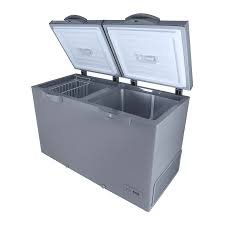Introduction: Why a Freezer Is More Essential Than You Think

Freezers have come a long way from being luxury appliances found only in large kitchens. Today, they’re considered a basic necessity in most homes. Whether you’re a meal-prepping enthusiast, someone who shops in bulk, or just love having ice cream on hand at all times, a freezer makes life easier in so many ways.
Think about it: without a , how would you store meat, frozen veggies, or even those leftovers from last week’s dinner? The modern doesn’t just help you save money by reducing food waste—it also helps you save time. You can cook in bulk, preserve seasonal foods, or stock up on sale items, knowing they’ll stay fresh for months.
What’s even better is that today’s market offers a wide variety of , catering to different needs, budgets, and kitchen sizes. But with so many choices, it can be overwhelming to pick the right one. That’s exactly what we’ll break down in this article.
Types of Freezers: Which One Fits Your Lifestyle?

When shopping for a freezer, understanding the different types available is key. Each one serves a unique purpose and is suited for different kinds of users.
1. Upright Freezers
Upright look similar to a regular refrigerator, standing vertically with shelves and compartments. They’re ideal for people who want quick access to their frozen items. With built-in shelves, it’s easy to organize food and avoid the hassle of digging through piles of frozen goods.
Another perk? Upright take up less floor space, making them perfect for smaller homes or apartments. However, they might not offer as much capacity as chest and tend to be a bit more expensive upfront. Still, the convenience and accessibility often justify the cost for many users.
2. Chest Freezers
Chest open from the top like a treasure chest, hence the name. These are known for offering more storage space and are usually more energy-efficient. Because cold air stays low and doesn’t escape as easily when the lid is opened, chest can help you save on electricity bills.
The downside? Organization can be a bit tricky. Items can get buried at the bottom, and you might find yourself digging through frozen bricks of food. That said, many chest now come with sliding baskets and dividers to help keep things manageable.
3. Drawer Freezers and Portable Freezers
For those who love convenience and a touch of luxury, drawer (usually built into kitchen cabinetry) are sleek and stylish. They’re perfect for smaller households or as a secondary for quick access.
Portable are great for camping, traveling, or for keeping in a vehicle. They run on electricity or even solar power, depending on the model. These are ideal for people who are always on the go but don’t want to compromise on chilled beverages or frozen snacks.
Key Features to Look for When Buying a Freezer
Buying a freezer isn’t just about picking one that fits your space. It’s also about getting the features that make your life easier and your food last longer.
1. Energy Efficiency
Look for a with an Energy Star rating. Not only does it reduce your electricity bill, but it’s also a more sustainable choice. Chest generally consume less power than upright models, but newer upright models have closed the gap considerably.
2. Temperature Control
A good should allow you to easily set and adjust the temperature. Some models even come with digital temperature displays and alarms to alert you if the temperature rises too high—super helpful during a power outage.
3. Storage Organization
If you’re someone who likes things neat and tidy, pay close attention to the storage layout. Adjustable shelves, baskets, and compartments can make a huge difference in how effectively you use the space.
4. Frost-Free or Manual Defrost?
Frost-free use a fan to circulate air and prevent ice buildup. While more convenient, they can be slightly noisier and consume more energy. Manual defrost models require you to periodically clean out the ice, but they’re quieter and often cheaper to run.
5. Noise Level
This might not seem like a big deal—until your is humming like a jet engine in your quiet kitchen. Always check the decibel rating, especially if you’re putting it in a living space or an open kitchen.
Best Practices for Using and Maintaining Your
Having a is great—but using it properly ensures you get the most value out of it.
1. Don’t Overpack It
A common mistake people make is cramming their until the door barely shuts. While it’s okay to have a full (it helps retain cold better), overstuffing blocks airflow and puts extra strain on the compressor. This can shorten the lifespan of your appliance.
2. Label and Date Everything
Freezer burn is the enemy of good-tasting food. By labeling and dating your food, you’ll avoid keeping things for too long and minimize waste. Use -safe bags and containers to prevent odors and moisture loss.
3. Keep It Clean and Organized
Make it a habit to defrost your freezer every few months (if it’s not frost-free) and do a full cleanout. Get rid of expired items, wipe down the interior with a baking soda solution, and rearrange contents so you know what’s in there.
4. Maintain Proper Temperature
The ideal temperature for a freezer is 0°F (-18°C). Anything higher risks spoiling food. Consider investing in a freezer thermometer if your model doesn’t have a digital display.
Freezer Safety Tips You Shouldn’t Ignore
Freezers are generally low-maintenance appliances, but there are still safety precautions to follow.
1. Keep it in a Cool, Dry Space
Placing your freezer in a hot garage or damp basement can reduce efficiency and even cause it to break down faster. Try to keep the freezer in a temperature-controlled area for optimal performance.
2. Avoid Using Extension Cords
Freezers draw a lot of power, and using an extension cord could pose a fire hazard. Plug the freezer directly into a grounded outlet and check that the outlet can handle the electrical load.
3. Be Prepared for Power Outages
A full freezer can keep food frozen for about 48 hours (24 hours if it’s half full). Keep the door closed during an outage, and consider having dry ice or frozen gel packs on hand for emergencies.
4. Child Safety Locks
If you have young kids, consider models with a lock or safety feature to prevent accidents. Some chest freezers come with heavy lids that could be dangerous if not handled properly.
Conclusion: Is It Time to Upgrade Your Freezer?
If your current freezer is always full, or if it’s making weird noises, leaking water, or not freezing properly, it might be time for an upgrade. Today’s freezers are more advanced, energy-efficient, and easier to use than ever before. Plus, they come in a range of sizes and styles to suit any home or lifestyle.
Whether you’re a home cook, a large family, or someone who just likes to be prepared, investing in a good freezer can save you both time and money in the long run. And with proper care and usage, your freezer can last you a solid 10 to 20 years.
So next time you walk past your frozen pizza stash or grab ice for your smoothie, give a little nod to the humble freezer—it’s doing a lot more than you think.
YOU MAY ALSO READ



